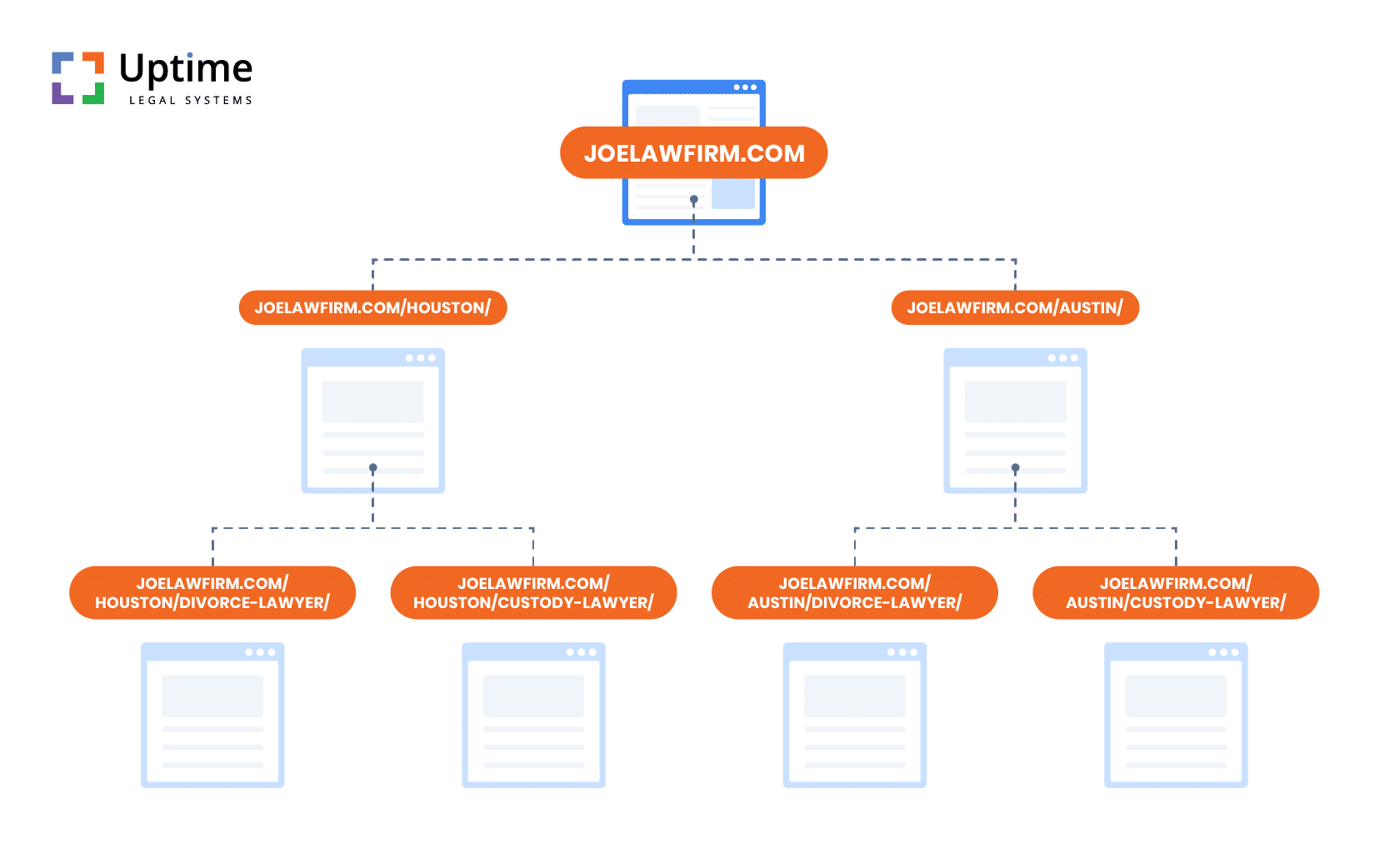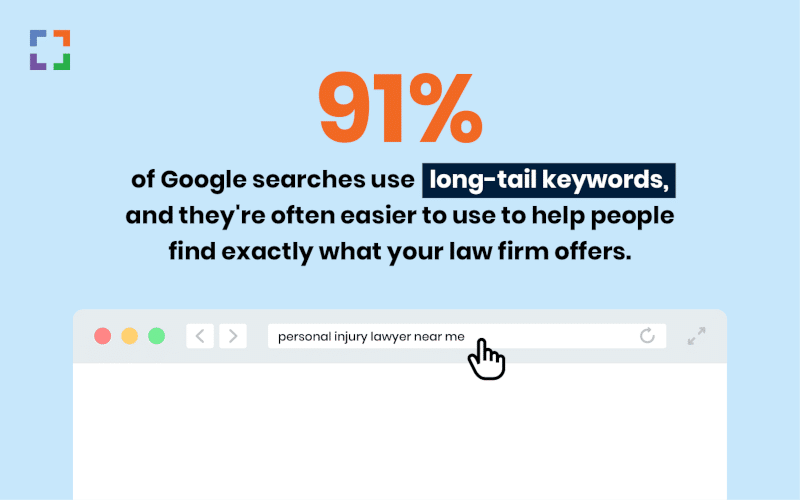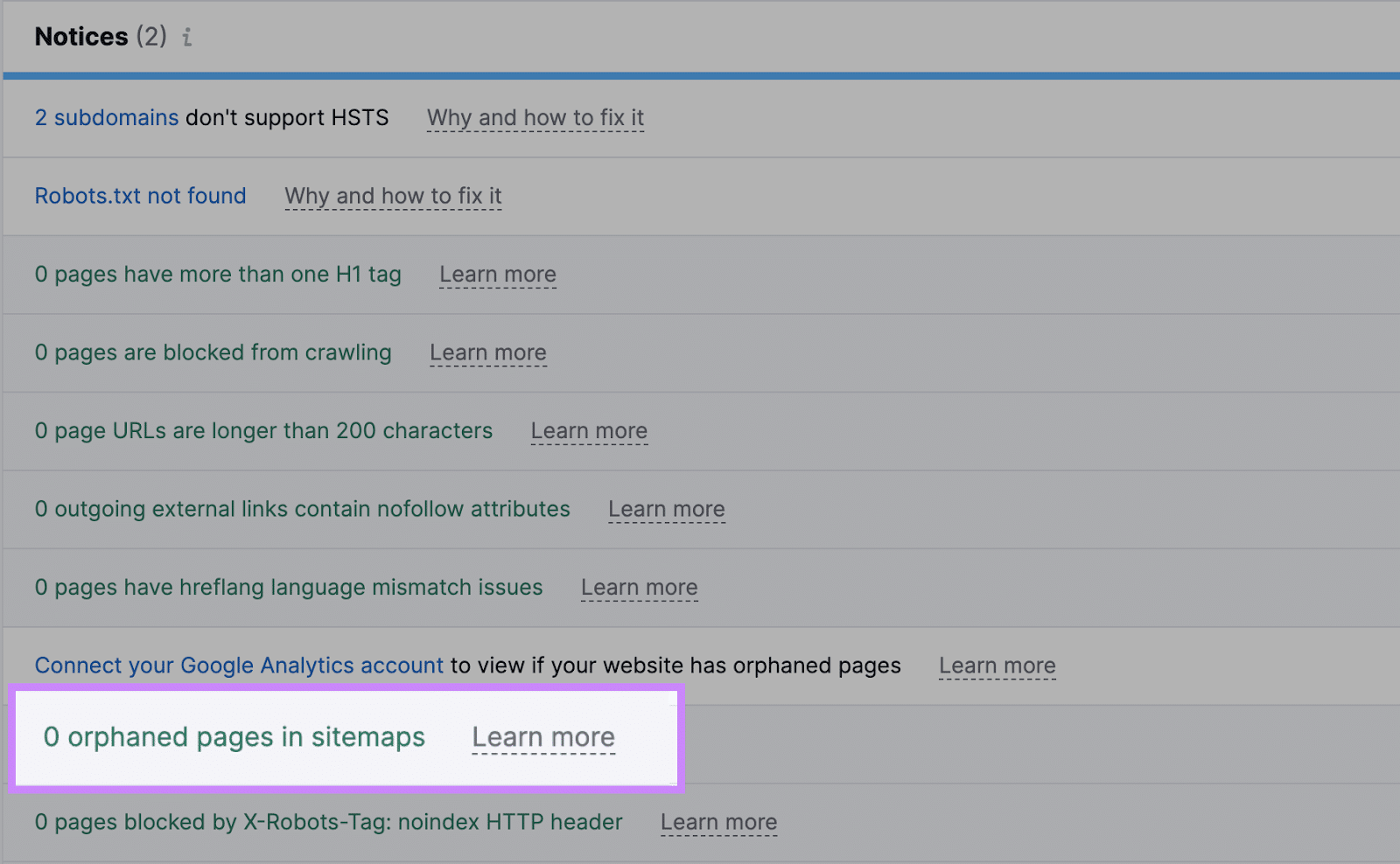
Lawyers and law firms need to stand out from the crowd and attract clients.
One of the most effective ways to achieve this is through law firm SEO. Two crucial parts of SEO are on-page (or on-site) and off-page (or off-site) SEO.
One involves optimizing your website and its pages to improve your search engine rankings and increase your online visibility, while the other involves external factors that improve your SEO.
In this chapter, we’ll cover the essential aspects of on-page SEO for lawyers, including content optimization using things like title tags and keyword research.
On-page SEO (also called on-site SEO) involves optimizing your web pages and their content for both search engines and users. When done right, it can improve your site’s rankings on Google and drive organic traffic.
With the right on-page SEO tactics, your law firm’s website can become a powerful tool that brings in tons of organic traffic and converts them into leads.
A lot goes into on-page SEO, including your site structure, content, and HTML elements.
When you really break it down, on-page SEO is about improving the user experience.
On-page SEO focuses on optimizing elements within your own website — like the content, HTML tags, and site structure — to improve rankings and user experience. It’s about making your site both search engine and user-friendly through relevant content, optimized titles and meta descriptions, and a well-organized layout.
Off-Page SEO centers on external factors that influence your site’s reputation and authority, primarily through backlinks from other sites. This involves strategies like link building, reputation management, and some aspects of local SEO to boost your site’s visibility beyond its own pages.
While on-page SEO lays the groundwork for your site’s visibility and usability, off-page SEO builds its credibility and reach.
Both are important, but as a business owner, you’re more in control of what’s on your website — your on-page SEO.
By optimizing individual web pages on your website, you can make your website more appealing for not only that page but for your entire website. It means getting placed more prominently on SERPs (search engine results pages) and an improved user experience, ultimately leading to higher rankings and more website traffic.
Because prospective clients increasingly rely on search engines like Google to find legal services, you need a well-optimized website to compete. With an SEO strategy, you’ll not only attract more visitors but also convert them into clients.
Your law firm could appear at the top of Google, like in this example.

On-page SEO lets you ensure your website is easily discoverable, showcases your expertise in a way that brings in clients, and provides valuable information that resonates with your target audience.
An appealing and user-friendly website will increase the likelihood of potential clients choosing your law firm over competitors while also communicating all of the right signals to Google.
Why does that matter?
The higher your website ranks in search results, the more visible it becomes to potential clients and the more organic traffic you’ll receive. And on-page SEO directly impacts your search engine rankings — if you follow best practices and provide valuable, user-friendly content, you’ll climb the SERP.
Google looks for relevance and checks whether your content is helpful, all with the goal of matching a page to a user’s search intent.
That means that Google pays attention to on-page SEO signals when ranking pages.
Although the algorithm is always changing, if you prioritize user experience and create “people-first content,” you’ll usually excel.
Now, let’s dive into actual on-page SEO elements and how to optimize for them.
You need to make it as easy as possible for users to navigate your website. They should be able to find any page they’re looking for without getting lost (which could lead them to leave your page in frustration).
You start with your homepage, and then you nest the rest of your content beneath the homepage.
There are two routes you can go with this.
They describe how deep your website structure goes or how many clicks it takes for a user to work their way through your website — also referred to as the crawl depth or click depth.
This is a topic of debate among SEOs. In our view, the flat structure is more suitable for simple websites, like a law firm with one practice area in a single geographical area.
A sub-directory style could work well for a large firm with many practice areas that operate across different cities.
A flat URL structure means your website’s pages all sit at the same level, right under the main website address, without any subfolders to tuck them into.
Each page gets its own distinct and clear URL that mirrors what the page is about, making it straightforward for both users and search engines to understand.
Here’s what a flat URL looks like.

A flat website hierarchy makes it so that a user can access your content in as few clicks as possible. That way, users don’t have to work too hard to find relevant content.
Here’s how that might look for your law firm’s website.

Take note of how few clicks it takes to get to the deepest page in the hierarchy. This is good practice for Google and its users.
However, if you have a lot of pages, you can run into a few problems. It can become challenging to organize hundreds of web pages, which makes it harder for users and Google to discover content.
Also, a flat architecture really relies on a solid internal linking strategy to provide context and help both users and search engines understand how your pages relate to one another.
Take note of how few clicks it takes to get to the deepest page in the hierarchy. This is good practice for Google and its users.
However, if you have a lot of pages, you can run into a few problems. It can become challenging to organize hundreds of web pages, which makes it harder for users and Google to discover content.
Also, a flat architecture really relies on a solid internal linking strategy to provide context and help both users and search engines understand how your pages relate to one another.

A deep structure could work well for a law firm with many practice areas operating in several cities.
However, studies have shown that shorter URLs (which coincide with flat website structures) tend to rank better. So, a deep structure may be overkill if you aren’t a massive firm with hundreds of pages.
One very important part of on-page SEO is proper keyword usage.
Keyword research shows you what people are typing into Google when seeking the legal services you provide. For instance, a personal injury attorney might find that their target audience frequently searches for “slip and fall lawyer in [city].”
From there, you can create targeted content designed to rank well for that keyword.
The first step is to identify the keywords most relevant to your practice areas and target audience.
These are the terms and phrases that potential clients use when searching for legal services that you offer.
You can use tools like Google Keyword Planner, Semrush, or Ahrefs to discover keyword ideas and learn about their search volumes, competition, and relevance.
In Semrush, for example, you’d start by typing your practice area into the Keyword Magic Tool.
From here, you could make a list of keywords you want to target.
A good place to start is to select keywords that include your practice areas and geographic location. That way, you rank for local traffic that’s more likely to reach out.
Incorporating long-tail keywords, which are longer and more specific phrases, can also help you target a more focused audience with a higher likelihood of conversion.
An example of a long-tail keyword is “slip and fall lawyer Chicago.”

With your list of keywords, you can begin to strategically embed them in your site’s content. Place them in your title tags, meta descriptions, headings, and throughout your page content to improve both visibility and engagement.
Title tags are encapsulated within HTML code and define the headline of your online content. These snippets appear at the top of browser windows and tabs, on search engines, and on social media.
Getting your title tag right is very important. It’s one of the most influential aspects that inform your on-page SEO.
When done right, a well-written title tag can help you rank higher in search results by communicating what your page’s topic is.
Title tags also influence a user’s decision to engage with your page.
They can look like this on the SERP (search engine results page).

To create effective title tags, follow these best practices:
Perfecting meta descriptions for your law firm’s website can help you attract more clicks on SERPs.
These succinct summaries appear beneath your page’s title in search results, offering a snapshot of what potential clients can expect to find on that page.
While meta descriptions don’t directly affect search engine rankings, they influence clicks, and more clicks send positive signals to Google that your page is helpful.

To create effective meta descriptions, follow these best practices:
An internal link connects one page of your website to another within the same domain, acting as a navigational guide for users and search engines.
Here’s what that looks like on a law firm’s site.
These links are fundamental in creating a structured, user-friendly website, ensuring that visitors and crawlers can easily find related content and navigate through your pages.
Internal linking is not just about improving navigation. It plays a crucial role in distributing link equity or link juice. When one page links to another, it passes value and authority from that page to another across your site.
This distribution can significantly boost the ranking potential of your key pages, making them more likely to appear in search results.
And a well-structured internal linking strategy can captivate your audience, keeping them engaged on your site for longer periods. Time-on-site is a metric that Google uses to determine whether a user found your page useful.
The longer users stay on your website, the stronger the signal to Google is that they find your content useful.
To weave an effective network of internal links, start by mapping out your site’s content.
Look for natural connections between your pages that can provide additional value or context to your readers. Each link should offer a clear path to relevant, related content, ensuring a cohesive user experience.
An easy way to do this is to utilize a hub and spoke model. In this model, your hub is the central piece of content that links to all related pieces of content.
To weave an effective network of internal links, start by mapping out your site’s content.
Look for natural connections between your pages that can provide additional value or context to your readers. Each link should offer a clear path to relevant, related content, ensuring a cohesive user experience.
An easy way to do this is to utilize a hub and spoke model. In this model, your hub is the central piece of content that links to all related pieces of content.

Here are some strategies to get started with thoughtful internal linking.
Develop Ample Quality Content: The foundation of a robust internal linking strategy is a diverse array of content. With more pages at your disposal, you have greater opportunities to create meaningful links without overconcentration on certain topics.
Link Naturally and Sparingly: While adding numerous links is tempting, prioritizing natural, contextually relevant links ensures your content remains accessible and engaging. Avoid overcrowding your content with links, as this can detract from the user experience and dilute the value of each link.
Prioritize the User Experience: Links should always be crafted with the reader in mind, not just search engines. Ensure each link adds value and enhances the reader’s understanding or navigation of your site.
Link To Relevant Pages: Only link between pages that share thematic connections. Irrelevant links can confuse readers and weaken your site’s structural integrity in search engines’ eyes.
By implementing these strategies, law firms can transform their websites into a cohesive, interconnected web of information that not only ranks well but also provides a superior user experience. Remember, the goal is to create a site where visitors can effortlessly discover the depth of your expertise, reinforcing your status as the legal authority they need.

“My website continues to dominate all the top website searches in my industry and my business has grown 10-fold as a result.”
Oykhman Criminal Defence
Without getting too technical, adopting legal service “schema” will also improve the structure of your law firm’s website and SEO.
Schema is a specialized code inserted into the backend of a website to help Google understand what that website is about.
By using legal service schema, you can communicate to Google what your website is about so it’s better able to categorize and rank your content.
You can add schema to your website by writing the code manually, using a third-party schema generator or ChatGPT, or hiring an SEO specialist.
Another type of schema we use for our client’s websites is review schema. We find it directly improves conversion rates.

You now know that page-load speed is an important ranking factor in law firm SEO.
Here’s what Google found about mobile page load speeds in a 2017 study.
It’s compelling data.
Besides the negative SEO effect, it’s fair to say that nothing damages user experience like a painfully slow website.
Google, and by extension, your potential clients, places a high premium on how quickly your website loads. A staggering 53% of web users are likely to abandon a site that takes more than three seconds to load, with a preference leaning towards websites that load in under two seconds.
Given the urgent nature of legal inquiries, it’s important for law firm websites to not only load quickly but be responsive on all devices.
Before you can improve, you need to know where you stand. Tools like Google PageSpeed Insights offer in-depth speed analysis, mimicking how real users interact with your site.
So, how’s your site’s speed? Check it using Google’s PageSpeed Insights (a free tool).
Here’s the result for one of our client websites.
As you can see, the page speed score is 91 percent. The average is between 50-89 percent.
Anything in the green is generally great and actually above average.
Improving your website’s speed involves a multifaceted approach, focusing on both the technical and content aspects of your site:
As you now know, on-page SEO is essential for any law firm looking to establish a strong online presence and attract leads.
If you focus on the above areas of SEO, including keyword research, optimizing title tags, and URL structure, you can improve your website’s placement on SERPs.
Ready to maximize your marketing budget? Fill out the contact form or call us today for a complimentary consultation. We will listen to your story, work to define your business objectives, and recommend an approach to deliver maximum ROI for your firm.
By using this website, you consent to our use of cookies in accordance with our Cookie Policy. Cookies help us enhance your browsing experience and provide personalized content. If you do not agree to our use of cookies, please adjust your browser settings accordingly.